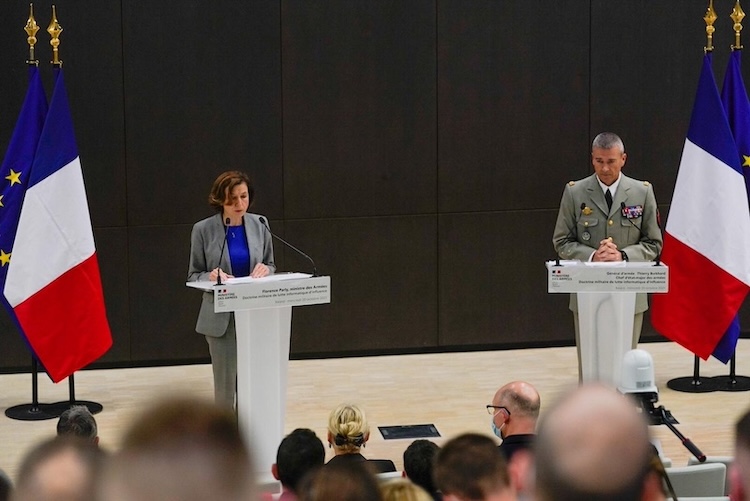France unveils a Cyber Influence Warfare doctrine

At a press conference on October 21, French Defense Minister Florence Parly and Army Chief of Staff General Thierry Burkhard presented the Military Doctrine of Cyber Influence Warfare (Doctrine militaire de lutte informatique d’influence - L2I). The publication of “public elements” of this doctrine may indicate that France recognizes and assumes the conduct of information operations, including on social media, but also demonstrates that a gap at a doctrinal level that exists in relation to Russia or China is shrinking.
The publication of the L2I was preceded by the creation of the French Cyber Command (COMCYBER) in 2018 and the publication of two documents - Defensive Cyber Warfare (lutte informatique défensive - LID) the same year, and Offensive Cyber Warfare (LIO) the following year. The publication of the L2I is an important element that should fill the doctrinal gap and provide a framework for the conduct of information operations by the French Armed Forces.
Russia was quick to react. Moscow rushed to denounce France through Russian Foreign Ministry spokeswoman Maria Zakharova of transforming “the information space into a battlefield in such an open way” and accused Paris of having “almost officially adopted a course on the militarisation of social media, on the transformation of auxiliary tools of ‘classic’ military propaganda into an independent type of weapon”.
Such a reaction from Russia is understandable, as the Kremlin is used to diplomatic, restrained language from the West. However, the Russian accusations are unfounded, given the country’s role in Information Warfare activities for at least a decade, if not more.
It’s also interesting to note that it was indeed Russia that crossed the ‘information sword’ with France in Africa last year, at least according to Facebook, Stanford Internet Observatory and Graphika. The latter two have published a joint report entitled More-Troll Combat in which they explain that France has responded to Russian informational operations, notably in Mali.
Taking this context into account, and in contrast to France’s policy of not attributing cyberattacks, we can assume that by revealing the “public elements” of the L2I, Paris is officially entering the Information Warfare playground where powers such as Russia, China, and other minor states have been active for some time now. However, one important difference that will distinguish French activities under the L2I from Russian activities, these activities exclude national territory and there is a pledge not to destabilise the electoral process in foreign states states.
According to Zone Militaire, military operations of influence (OMI) were conceptualised in 2008 in the Doctrine interarmées (DIA) 3.10.1. This work was carried out by the Centre interarmées de concepts, de doctrines et d’expérimentations (CICDE).
The L2I Doctrine explains the new term Influence Cyber Warfare which should be understood as:
“military operations conducted in the information layer of cyberspace to detect, characterise and counter-attacks, support the StratCom, provide information or conduct deception, autonomously or in combination with other operations”.
The document acknowledges that Information Warfare is already a “daily reality” for the French army, and describes the objectives and types of operations. For example, among the military objectives of L2I, we can find the following: “detect and characterise adversary information attacks” or “weaken the legitimacy of our adversaries”. As for the types of L2I military operations, the document notes activities aimed at “inducing the adversary into error to make him reveal his intentions or device”, “promoting armed forces activities on social media” or “denouncing the adversary’s inconsistencies or lies”.
An essential element of this doctrine is respect for the national legal framework and international law. The authors have written a separate chapter explaining that, in peacetime, L2I military operations “respect the United Nations Charter and the principle of non-interference”, and that they fall within the “legal framework applicable to the engagement of armed forces”.
We also learn who will be in charge of L2I operations, where the COMCYBER will have operational control and “human resources and technical means dedicated to L2I” will be concentrated within the Centre interarmées des actions sur l’environnement (CIAE), which “already groups together French military influence actors”.
According to public information, L2I operations are reminiscent of IMOs in that they will be concentrated mainly in areas where French troops are present or about to be deployed - in other words, mainly in the African theatre. However, the Doctrine does not limit the application of computer-based counter-influence operations to this geographical area, which indicates that operations in the enemy’s information space are indeed possible.
On the other hand, L2I activities should not be confused with cyber operations and other initiatives, such as those carried out by Viginum, a recently created agency focused on analysing and combating foreign disinformation aimed at destabilising the French state.